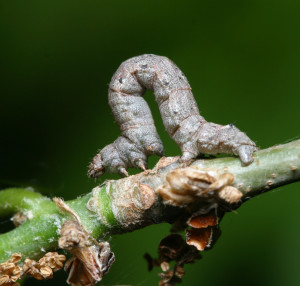
Dark form of the spring cankerworm. Note the three pairs of true (jointed) legs on the front of the body, and the two false (un-jointed) legs on the abdomen. The lack of legs in the middle of the body causes a cankerworm to walk in the typical “inchworm” fashion.
This week I’m receiving reports about spring cankerworm infestations in counties west of the Fort Worth, Texas area. Spring cankerworms (actually caterpillars, not worms) feed on a wide range of trees, and can defoliate trees in early spring. Although cankerworms are present in low numbers every year, periodically conditions are right for widespread outbreaks. The last time I remember this happening in the Dallas area was about 11 years ago.
If the reports are correct, this might be another “year of the cankerworm”–at least in some Texas counties. And as if to confirm this prediction, a few minutes ago a spring cankerworm dropped on my shirt from the oak tree outside my office this morning. Cankerworms, like many caterpillars, produce silk from their mouths which they use, like Spiderman, to swing from tree to tree, or to drop to the ground.
When cankerworm outbreaks occur, they can produce some of the most spectacular tree defoliation events seen in this part of the country. If you have a chance to walk through an infested forest you will see millions of tiny caterpillars hanging from tree branches and blowing on the wind. After a week or two of feeding, trees can be largely stripped of leaves.
Fortunately, these outbreaks normally pose little danger to trees, especially trees in woodlots and forests. Healthy trees on good soil can usually withstand total defoliation without significant damage. Trees that lose their leaves to spring cankerworms generally re-leaf and show no signs of long-term damage. However, trees that are under stress from drought or transplantation may benefit from a timely insecticide application, before the leaves are stripped.
If treatment is needed, sprays containing Bacillus thuringiensis (Bt) or spinosad will be the safest for beneficial insects and bees. These sprays should be applied early, before the caterpillars reach their full size. If you can’t treat early, it may be best not to treat; however other insecticides, such as carbaryl, permethrin, cyfluthrin and other pyrethroid insecticides can provide effective and rapid control of all sizes of caterpillars.
Cankerworms belong to the moth family Geometridae. Spring cankerworms range in color from light green to brown. Like all geometrids, spring cankerworms have fewer than normal caterpillars. Where normal caterpillars have three to five abdominal feet, spring cankerworms have only two. The result is a distinctive looping walk, giving these caterpillars their common name “inchworm”. Click here to see a video of this walk.
Larvae (caterpillars) hatch from their egg masses in the spring when trees are reaching bud break. They grow to about one inch long and are quite slender, often with a light green stripe along their sides. When not walking, the caterpillar’s drab color blends in well with the twigs on which they rest.
Larvae typically feed for 3 to 4 weeks before dropping to the ground to pupate. Fortunately, the spring cankerworm produces only one generation a year, so ongoing spray treatments are not necessary. Both the spring, and the less common fall cankerworm, feed only on broad leaf trees and should not pose a threat to your other garden plants.